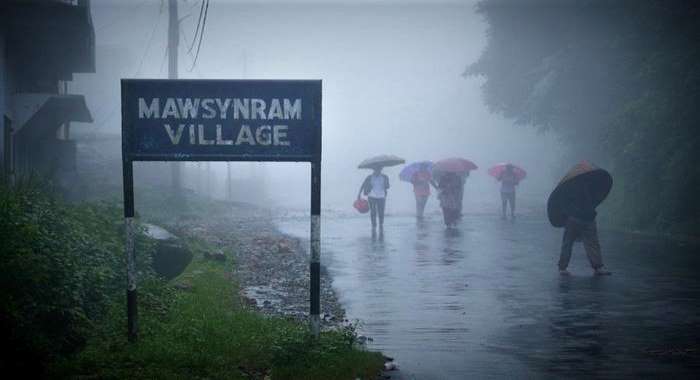
MAWSYNRAM:
The world knows Mawsynram for a single, powerful reason: its record-breaking rainfall. However, an exclusive interview with Hiambor Rapsang, the Chairman of the Synjuk ki Nongialam Shnong (United Village Leaders) of Mawsynram reveals a different story—one of a community striving for progress amidst a unique set of challenges. The Chairman, who has been in a leadership role for 30 years, articulates the long-standing and urgent demand to upgrade the Mawsynram C&RD Block to a Civil Subdivision. The struggles of the people, which have been ongoing for more than two decades, reveal a side of their story never truly portrayed in the media.
For the residents of Mawsynram, the global recognition of their home as the wettest place on Earth is a double-edged sword. While it’s a source of immense pride, that fame stands in stark contrast to the daily struggles they face. “The glory goes to the state and the country, but we are the ones facing these problems for many years,” the Chairman states. The constant, heavy rainfall, while celebrated by the outside world, is often a nuisance for locals. The incessant downpour hinders their ability to perform daily activities, from cultivating land to selling goods at the market, all of which are made more difficult by the region’s inadequate infrastructure. The very element that brings Mawsynram its fame is also a constant source of misery, a reality that feels deeply ironic to the people who live it every day.
From Fame to Function
The Chairman and the village leaders are not simply asking for a name change; they are demanding a new identity for Mawsynram, one built on functionality and progress rather than just on fame. The primary objective behind the push for a Civil Subdivision is to bring essential government and administrative services closer to the people. For decades, the distance to Shillong, the district headquarters, has been a significant barrier. This distance which is 60 km, is more than a simple measurement; it represents a significant barrier to essential services. For people in remote villages, particularly those in the Ri-war areas who must navigate steep hills, a trip to Shillong for even a small errand can consume an entire day. A Civil Subdivision would mean that residents would no longer have to make the arduous 60-kilometre journey for critical needs like administrative paperwork, healthcare, and education. This would dramatically improve the quality of life for the entire community. This is the “unheard cry” the Chairman speaks of, a plea for the government and the public to look past the dramatic headlines about rainfall and see the real needs of a community. The demand is a powerful testament to a united community that has grown tired of waiting. They believe that if the region is given the proper administrative and developmental focus that a subdivision would provide, it could finally translate its natural fame into tangible, lasting benefits for its people.
“In sickness, education and many more they have to race to Shillong,” he says, painting a vivid picture of the constant uphill battle residents face. This challenge is compounded by the traffic congestion in Shillong, which can turn a 60-km journey into a gruelling three-to-four-hour ordeal. For residents, this is not just about a longer drive; it’s about a complete loss of time and resources. The Chairman recalled a meeting where the headmen had to leave Mawsynram at 9 AM for a 2 PM appointment in Shillong, just to account for the traffic, the search for parking, and the general chaos of the city. For those seeking jobs, access to markets, or even basic healthcare and education, this lengthy and costly commute is a heavy and constant burden.
This shared struggle has united the headmen under a single umbrella, giving their collective demand for a Civil Subdivision a powerful, unified voice. The establishment of a subdivision would bring these vital services closer to the people, effectively decentralizing power and cutting down the travel time for all residents. It would mean bringing administrative offices, market access, and advanced healthcare facilities to Mawsynram, Mawphlang, and Sohiong. The Chairman also pointed out that this move would be beneficial not just for Mawsynram, but for Shillong as well, as it would decrease the traffic congestion that has become a major issue for the state capital. By bringing services to the people, the government could alleviate the burdens of Mawsynram while simultaneously relieving the strain on Shillong’s infrastructure.
ALSO WATCH INTERIEW IN KHASI:
A Paradox of Fame: Rain, Roads, and Lost Potential
The Chairman highlights the severe lack of adequate infrastructure as a primary concern, a situation made even more complex by the region’s famous downpours. The very rain that gives Mawsynram its fame is also responsible for frequently wrecking roads, creating a constant state of disrepair that poses safety hazards for drivers and pedestrians alike. This relentless cycle of damage not only makes daily life difficult but also cripples the region’s economic potential. During the monsoon season, roads can become treacherous, leading to safety issues and a complete disruption of local commerce.
“The fame we receive with the heavy rainfall does not have any value,” he emphasises. Rapsang explains that while the world celebrates the rain, locals are left to contend with the consequences of it. This lack of proper roads and basic infrastructure prevents tourism from thriving, which is a major missed opportunity. In a heartfelt moment, he expressed a profound sense of abandonment, feeling that Mawsynram has been left behind “like orphans with no parents.” He elaborated on this feeling, recalling trips to other nearby tourist destinations and feeling a deep sense of shame upon returning home and seeing how much Mawsynram lacked in comparison.
The nearby tourist hubs like Sohra, Dawki, and Mawlynnong are examples of what Mawsynram could be. These destinations have attracted visitors from across the globe, generating significant economic benefits largely due to their developed infrastructure and ease of transportation. The resulting tourism boom has created jobs and employment opportunities for local youths, helping to combat unemployment. Mawsynram, which already has international fame, possesses the same immense potential. However, until it receives the necessary infrastructure upgrades, it will remain largely unexplored by all but the “adventurous” few, and its potential to become a significant economic driver will continue to be a paradox.
An Urgent Need for Better Healthcare Facilities
The situation with healthcare is equally dire. While the Chairman expresses gratitude for some recent government initiatives, he describes the current state of healthcare as “very bad.” The community’s only major hospital is the Community Health Centre (CHC) in Mawsynram, and he explains that it is “not proper yet” and is simply insufficient for the large population it serves. Smaller Primary Health Centres (PHCs) are scattered in border areas, including locations like Dangar, Lawbah, and Sawsymper. While these facilities exist, they are under-equipped and struggle to meet the needs of a vast and geographically challenging region. For any serious medical emergency, residents face the same arduous 60-km journey to Shillong, a trip that can be life-threatening for those in critical condition.
However, a glimmer of hope exists. Rapsang mentioned that he and other leaders recently met with Health Minister Dr. Ampareen Lyngdoh to discuss a solution. He expresses hope that a new Referral Unit, which is currently being prepared, will be completed by the end of the year. This new facility would be a crucial asset, offering more specialised care than a standard CHC. He particularly emphasises its importance for vulnerable groups like women and pregnant mothers, as it would provide a much-needed local option for complex medical needs, potentially saving lives that might otherwise be lost on the long journey to Shillong.
ALSO WATCH RELATED VIDEO IN KHASI
The Struggle for a Secular Tourist Spot
The interview also touched upon the contentious issue surrounding the Mawjymbuiñ Cave, a major tourist attraction in the region. Drawing from his long experience as a village leader, the Chairman stresses the importance of peace, respect, and unity in diversity. His philosophy is rooted in a fundamental Khasi teaching: “Never take what belongs to others.” He further says, “If we can respect others, others will also respect us and so we can all live in peace.” This principle, he argues, is the bedrock of a harmonious community, but it is put to the test when secular spaces are encroached upon. He recounted a specific incident where tourists who came to the cave were asked to take off their shoes. The tourists, surprised and confused, responded that they were simply visitors and had come there countless times before without being asked to do so. This kind of action, he says, creates a “disruption of peace” and makes tourists feel unwelcome. The Chairman believes that when religious activities become too prominent in a public space, it can create a sense of exclusivity.
While a recent High Court decision to allow only the sprinkling of water is a step toward resolving the dispute, the Chairman, on behalf of the Dorbar Shnong (village council), believes it is essential to maintain the cave as a completely secular tourist spot. He argues that this approach will ensure harmony and a welcoming environment for all visitors, respecting India’s constitutional value of unity in diversity. The village leaders intend to appeal the decision, holding firm to the belief that the cave’s future as a successful tourist destination depends on its ability to welcome everyone without distinction. This issue is not just about a cave; it is about defining the cultural identity of Mawsynram and ensuring its main attractions contribute to the community’s economic well-being through inclusive tourism.
A Glimmer of Hope for Mawsynram’s Future
In closing, the Chairman remains optimistic that the recent meeting with the Chief Minister, Conrad K. Sangma will be fruitful. He described the discussion as “very positive” and feels that their long-standing demands will finally be met this time. He and his fellow leaders believe the government will now proceed with the necessary administrative procedures. “If we work together,” he concludes, “then good changes will surely come.” This is more than just a statement of hope; it is a powerful appeal born from decades of unified struggle. The united leaders of Mawsynram are not just asking for an administrative upgrade; they are making a powerful appeal for development, peace, and the right to a better quality of life. The Civil Subdivision is seen as the first crucial step toward unlocking the region’s full potential, bringing essential services, improving infrastructure, and fostering economic growth through tourism. The community’s collective voice is a testament to its resilience, demanding that Mawsynram be defined not by its past struggles but by the promise of its future.
(Edited by Marba Rani)






